Episode 73 Show Notes
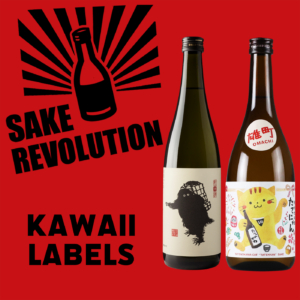 Episode 73. Can you judge a book by its cover? Or a sake by its label? This week, John and Timothy put this to the test. Now there are a lot of label styles out there, so they each found a sake label with a common style: a “kawaii” or super cute label on the bottle. One is a Muppet-like abominable snowman with a shaggy coat and saucer-like eyes. The other is an adorable kitty drinking sake while surrounded by symbols of good luck. When we looked a little deeper, both labels actually have a surprising connection to their brewery. We’ll discuss how labels might influence our buying decisions and how super cute labels in particular can transcend language and grab our interest. Join us to see if the taste of these sakes matches well with their adorable appearance. Meow!
Episode 73. Can you judge a book by its cover? Or a sake by its label? This week, John and Timothy put this to the test. Now there are a lot of label styles out there, so they each found a sake label with a common style: a “kawaii” or super cute label on the bottle. One is a Muppet-like abominable snowman with a shaggy coat and saucer-like eyes. The other is an adorable kitty drinking sake while surrounded by symbols of good luck. When we looked a little deeper, both labels actually have a surprising connection to their brewery. We’ll discuss how labels might influence our buying decisions and how super cute labels in particular can transcend language and grab our interest. Join us to see if the taste of these sakes matches well with their adorable appearance. Meow!
Skip to: 00:19 Show Opening
Welcome to the show from John and Timothy
Skip to: 01:23 Kawaii and Sake Labels
“Kawaii” means cute or adorable and is a popular term in Japanese. John and Timothy explore and discuss the impact of labels on sales and marketing.
Skip to: 13:48 Sake Introduction: Yuki Otoko Junmai
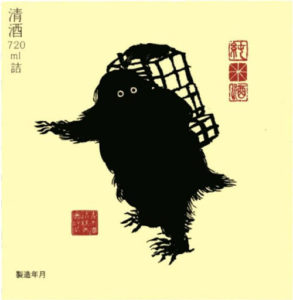
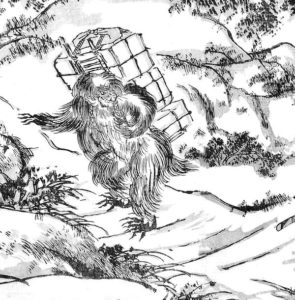
Left: Modern Yuki Otoko Label.
Right: Historical Drawing of a “yuki otoko” snow man/yeti from Niigata
Skip to: 19:20 Sake Introduction: Tatenokawa Tatenyan Junmai Daiginjo
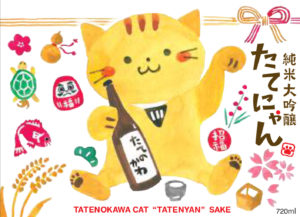
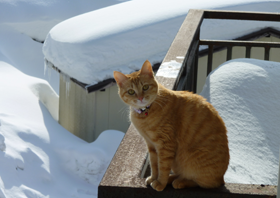
Left: Close up of Tatenyan sake label.
Right: Photo of the real “Tatenyan” sake cat living at Tatenokawa!
Skip to: 23:12 Sake Tasting : Yuki Otoko Junmai
Yuki Otoko Junmai
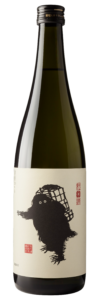
Brewery: Aoki Shuzo (Niigata)
Classification: Junmai
Acidity: 1.2
Alcohol: 15.5%
Prefecture: Niigata
Seimaibuai: 60%
SMV: +12.0
Rice Type: Miyamanishiki
Importer: Niigata Sake Selections
Brand: Yukiotoko (雪男)
View on UrbanSake.com: Yuki Otoko Junmai
Skip to: 27:03 Sake Tasting : Tatenokawa Tatenyan Junmai Daiginjo
Tatenokawa Tatenyan Junmai Daiginjo
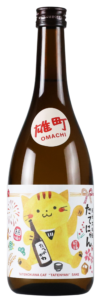
Brewery: Aoki Shuzo (Niigata)
Classification: Junmai
Acidity: 1.2
Alcohol: 15.5%
Prefecture: Niigata
Seimaibuai: 60%
SMV: +12.0
Rice Type: Miyamanishiki
Importer: Niigata Sake Selections
Brand: Yukiotoko (雪男)
View on UrbanSake.com: Tatenokawa Tatenyan Junmai Daiginjo
Skip to: 32:16 Show Closing
This is it! Join us next time for another episode of Sake Revolution!
Announcing Patreon
 Now there is a new way to support Sake Revolution. Join us on Patreon! Patreon is an online platform that allows you to support your favorite creators by subscribing to a monthly membership. At Sake Revolution, we’re offering two tiers, each with its own perk. If you enjoy our sake podcast, if you are able, please consider supporting this labor of sake love! See below to learn about our Patreon support levels.
Now there is a new way to support Sake Revolution. Join us on Patreon! Patreon is an online platform that allows you to support your favorite creators by subscribing to a monthly membership. At Sake Revolution, we’re offering two tiers, each with its own perk. If you enjoy our sake podcast, if you are able, please consider supporting this labor of sake love! See below to learn about our Patreon support levels.
-
Sake Enthusiast
Have you ever wanted to sip along with us as we taste our sakes on the podcast? Now you can! As a Sake Enthusiast patron, you’ll get the inside track and know in advance which sakes we’ll be featuring on the show. This allows you to get them on hand and sip along with us while you listen.
-
Sake Otaku
As a Sake Otaku supporter of the pod, you’ll get access to all the Sake Enthusiast intel along with access to a monthly live zoom Sake Happy Hour taking place the first Weds of every month at 9pm ET (6pm PT). Visit with us live on zoom! Come with all your questions and suggestions and enjoy a relaxed and fun Happy Hour with with us as we all sip sake together!
Episode 73 Transcript
John Puma: 0:21
Hello everybody. And welcome to Sake Revolution that would be America’s first sake podcast and I am your host, John Puma from the Sake Notes. Also the administrator over at the internet sake discord and lead mod over at Reddit’s r/ Sake community, where we get together and often talk about Sake labels, for purposes of this show though, I am the guy who’s a Sake nerd like you guys, and definitely not the Sake samurai. I leave that to my co-host.
Timothy Sullivan: 0:55
And I am the co-host Timothy Sullivan. I am a Sake Samurai, sake educator, as well as the founder of the Urban Sake website. And every week you will find John and myself here tasting, and also chatting about all things, sake and doing our best to make it fun and easy to understand.
John Puma: 1:14
Hmm. I like that fun part because we’re really going to be doubling down on, I think, on the fun today, or at least that’s the goal.
Timothy Sullivan: 1:23
John, I understand you’ve been studying Japanese. Is that right?
John Puma: 1:26
Um, it would be accurate to say that during the pandemic, there was a long stretch of about a year where I was really studying Japanese. It was also accurate to say that I have not been studying Japanese very much in the past two months or so.
Timothy Sullivan: 1:39
So you’re using, you’re using the Timothy Sullivan method of learning Japanese, which is stop and start, stop and start. Well, I’m going to ask you if you know, a very famous Japanese word. Do you know what kawaii means?
John Puma: 1:54
Um, yes. That is something that they teach us pretty much on day one. It means cute.
Timothy Sullivan: 2:00
Cute. Yes. It does mean cute. Think. Hello, kitty. Right? That’s the ultimate kawaii.
John Puma: 2:11
I think so. And, and I think that, uh, you know, kawaii, I think that when, uh, Americans here, uh, Japanese words, that’s like one of the first ones that they pick up on because it gets used a lot in popular culture. Um, but yes, it does mean cute or adorable.
Timothy Sullivan: 2:26
Yes. And why are we talking about kawaii today?
John Puma: 2:31
Because sake labels can sometimes be very kawaii.
Timothy Sullivan: 2:35
Yes, that’s right. We’re going to be talking about super cute sake labels and sake labels in general. I think that’ll be a good
John Puma: 2:44
he labels in general. We don’t want to restrict ourselves too much, but yes, uh, cute sake labels, uh, informative sake, labels, fun sake labels. I think this is going to be a little bit of a fun one today.
Timothy Sullivan: 2:57
And you and I have both picked out a label that we think is super kawaii super cute. And we’re going to taste those later in the show. But for now I wanted to ask you a question about sake labels in general. I remember when I was first starting out tasting sake. I didn’t know one from the other, I didn’t know anything about SMV or any of that stuff. And the label was really what I had to go on when I was standing in the shop and looking at. The sakes on the shelf. Do you think it’s Okay for beginners to buy sake based on the label alone?
John Puma: 3:33
Well, Tim, I think that when we first get into sake, we don’t have a choice. Um, you know, when we don’t really know a lot about sake and we want to get a little adventurous and we’d go to a sake shop, what can we do? But look at the labels, right? And see what looks interesting to us. Or kawaii if we’re into that. But, uh, but interesting, I think is also important. uh, if you’re in a, a shop that has a more, uh, boutique-y feel to it, there’s usually very informative staff that you can talk to. But for purposes of our conversation today, we’re talking about just buying things based on label. And I think you can. Yeah, you can do that. I’ve done it. I’m sure you’ve done it. I’m sure everybody that’s listening to this has at some point or another walking into a store or been in a restaurant and looked at a label and was like that one looks cool. I’m going to have that.
Timothy Sullivan: 4:22
Yeah, I admit it when I was first starting out. I totally did that. But you have to take some chances. You have to roll the dice and trying a Sake based on the label can be a really rewarding experience and it can Also blow up in your face too.
John Puma: 4:39
Also backfire spectacularly.
Timothy Sullivan: 4:43
Yeah. And there’s all different types of sake labels. I don’t know if you think this, John, but I think. In the last five years or so, brewers have been getting more active with redesigning their labels and coming out with cuter, more engaging things, stepping away from that super traditional old fashioned sake look and having more dynamic labels.
John Puma: 5:06
And, and when we say that super traditional old style sake label, look, you’re talking about just like the white background or the colored background with just a lot of Kanji on the front. Is that, is that what you’re going
Timothy Sullivan: 5:17
Yeah, I would say Kanji heavy. So the Japanese writing system is called Kanji. And if there’s a lot. Kanji. And there’s just this look to like, you know, 1950s, 1960s designed labels that are very conservative, a little stodgy maybe, and very traditional. And, you know, people are asking, oh, is it better to stick with the label we’ve had for all this time? Or do we redesign it and make it dynamic for a new generation? So a lot of more traditional breweries I think are up against that question. And I don’t think there’s anything wrong with redesigning. I think it’s, it’s fun and exciting to get a new label out there.
John Puma: 5:58
Yeah. And, you know, as a foreigner, uh, I think it’s kind of great. And I do think that because export is a much bigger deal for these breweries and will continue to be, I think it is a question they need to ask themselves. And it is a question that more and more often we see them going for, and we see them people making changes or simplifying the labels. what kind of things do you kind of like About sake labels. Like when, when you’re you’re, now that you’ve been at this for a long time and you’ve been a sake educator for, for ages, uh, didn’t mean to blow up your spot there. But, when it comes to these like redesigns and stuff like that, what kind of, what kind of things do you think help the consumers here?
Timothy Sullivan: 6:39
This ties in really nicely with something I was going to ask you, and we can talk about these together, which is English on sake labels.
John Puma: 6:46
Hmm.
Timothy Sullivan: 6:47
how important is that? And we’re, we’re both in the export market. So, uh, our friends and customers and people we work with and drink with, I think they appreciate some English on the label. And when a label is redesigned by a brewery, my counsel, if they ask me, what’s your opinion, I always say, having a little English somewhere on there for people to read, if this is on the shelf in New York, or, somewhere in the U S having that English on the label is just goes a long way to helping people remember the brand name or remember the brewery name. And I think it helps a lot.
John Puma: 7:23
I think so too. It really, helps you engage a little bit more with the brand right away. at the very least I’d love to see some English, you know, and if they can’t do that, then what I’ve seen in a lot of cases is bill stylized. So they’re still gonna use the kanji, but they stylize it in a way where it looks a little bit more like a little more like art. it becomes very striking and you’re just looking forward to that thing and you go like, oh, I like that one. You know, it, because it looks very distinctive. It looks very beautiful. And you’re just kind of have that in your head, uh, kind of that. And, uh, I’ve also become a really big fan of, uh, of color coding on labels. So if you do like a nice striking piece of art on your label, and then you either color, you know, color the letters or the background. to go along with like, a year at different grades or different products, different races or different products. It, it really makes people, you know, it simplifies it so much for the, for the Western consumer, because they can just go like, oh, I know this one, I’ve had the blue one. I want to try the red one. And it like, it’s super easy for you to just remember which one you like, because all you don’t even have to think about the name. All you had to do is remember the color. And I think that’s a lot of fun, especially for people who are new to sake.
Timothy Sullivan: 8:35
Yeah. no, I know. I just said that in my opinion, English on labels is important, but there are some breweries that just do a graphic image that is so striking and so unique and so memorable that I think it kind of transcends language too. So there are some labels that, you know, they must hire really, really good graphic designers who come up with these striking images. You remember them there they’re very memorable. They don’t blend into the crowd. And I think both of our cute labels today are in that category where they’re just so memorable that you don’t necessarily need that much English because you can remember the image.
John Puma: 9:14
And having some English on there as well, always a big plus, like I think that’s, that’s a great thing as well. There is a, there’s a brand that I think that both of us are familiar with that I think does the kind of nice graphic with the color coding and some English and nice way that makes it very easy to remember. And that’s a Shichida.
Timothy Sullivan: 9:32
Yeah. Yeah.
John Puma: 9:33
They have the Kanji on there, but it’s very, very stylized and to a Western area kind of just looks like really nice art. and then. Each of their different labels. The label design is the same on all of them, but the background color is different on every single one of them. And then underneath it says Shichida in English. And it’s very easy for you to remember the brand because of that. And then with the colors, it’s really easy to just, to, to pick them off and know which one you had before and know which ones you’d liked. It’s a really good idea.
Timothy Sullivan: 10:03
Yeah. So with Shichida, it’s very slick. Very well-designed minimal, But it doesn’t fall into the cute category. it’s a very elegant. look, isn’t
John Puma: 10:13
it’s elegant. It’s not cute. We will say that it’s more elegant than cute on the chart. We need a chart that’s like elegant or cute. And the Shichida is definitely in the elegant category. Very well designed. but our focus today is cute. I’m very curious. How much do you, as far as, you know, how much does the label influence the sales?
Timothy Sullivan: 10:35
Mm,
John Puma: 10:36
Does it have the desired effect or is, is there any evidence of that?
Timothy Sullivan: 10:40
that’s a great question. I don’t have a ton of insight into that. But I would say it’s similar to the wine world where I’ve heard it said in the wine world that a label can make or break a new release of wine. And you want to make sure that the label lines up with the brand and the price point and the marketing, and that all works together to make a successful release of a new wine. And I think for sake, it’s similar. In order to stand out in the new world of sake sales with all these energetic brands coming out, that it really is important to have an engaging, energetic label to, make people reach for that bottle. Say, what is that to peak people’s interest.
John Puma: 11:34
I agree. Um, and there’s, there is evidence in and other alcohols. I don’t have a tale specifically about wine, but there is an old, uh, an old, an old story of, uh, a Brandy company.
Timothy Sullivan: 11:49
Hmm.
John Puma: 11:50
Had a competitor come in with a nicer label and they started to lose market share to this new competitor. And they were trying to wonder like, what is this competitor doing that we’re not? So they, they scheduled blind tastings with, with experts and the experts all preferred there they’re Brandy. They did blind tastings with regular people. The regular people for the most part shows their Brandy all in blind tastings. When they started to show them the bottles, the people chose other brand, even though blind, they chose the, um, they chose that first brand. So they went on to redesign their bottle, to be a little bit more similar to the competition and boom, it completely even things out. And they went back up and sales. So the, the design of the bottle design of a label influences. The way you think about something that influenced the way you taste it, in some
Timothy Sullivan: 12:46
Wow. That’s really fascinating.
John Puma: 12:48
Your relationship with a beverage starts when you look at the bottle it’s really weird. It’s just, it doesn’t make a lot of sense to us, but, but it is something that, humans experience. it’s fascinating and very interesting.
Timothy Sullivan: 12:59
Yeah, that is really interesting. I think we can agree that the label is super important and can really influence sales A lot. Well, it’s time to get kawaii up in here.
John Puma: 13:15
is it all right? This is a lot of fun. I just really, I really love cool looking sake, labels, love cute sake labels. and this is going to be a fun, little back and forth we’re going to do here. I think so. So Tim, why don’t you go first and first I want you to
Timothy Sullivan: 13:31
Okay.
John Puma: 13:32
first, I want you to tell me, tell me a little bit about the sake team. I want you to focus on that label. Tell me what you’re seeing and paint a word picture for our audience at home. Even though you guys can go to the show notes and see pictures of the label we want you to really, I want to get as much in your head as we can on the show here.
Timothy Sullivan: 13:48
Yeah. So my sake label is super cute and it has a really deep and kind of Historical background. So the SA yes.
John Puma: 13:59
historical
Timothy Sullivan: 14:00
Yes. Historical cute.
John Puma: 14:02
Oh, I am excited.
Timothy Sullivan: 14:03
Yes. So the sake that I picked is Yuki Otoko Junmai. This is often Yukio Toko.
John Puma: 14:11
yuki otoko? So that’s snow man snowman.
Timothy Sullivan: 14:16
Well, the, the nickname in English is Yeti and sometimes called abominable snowman.
John Puma: 14:25
I like
Timothy Sullivan: 14:25
it’s like, it’s like Bigfoot kind of, and it’s a mythical creature that. lives in the mountains of Niigata. So. It is a not totally scary, but uh, sometimes helpful. Uh,
John Puma: 14:44
Hm,
Timothy Sullivan: 14:45
Covered with hair like a Bigfoot or a Yeti and lives in the snow covered mountains. So the label that I picked was the yuki otoko Junmai and there is a drawing black and white drawing of the snowman carrying. Packages on his back with two white eyes. So the outline of the snowman is all black and you can see his fur all around him and he’s carrying packages and this creature was known to help. Wayward travelers carry their packages through the snow to get over the mountain. So that’s why he’s pictured with the carrying the bundles on his back. And his two little eyes are just peering out at you. Two white eyes in this black furry, like, almost like a Muppet, right? It looks like a Muppet a little bit. Anyway, if you want to see this Yukio Toko you have to check the show notes, SakeRevolution.com.
John Puma: 15:43
I’m going to show my age here a little bit, but when you described it, I imagine like the abominable snowman from the Rudolph, the Red-Nosed reindeer, a little amatronic cartoon cartoon, the right word, whatever it was that we’ll show from. Stop motion. Yeah. Stop
Timothy Sullivan: 15:57
Is it? I think it’s Claymation. Well, whatever.
John Puma: 15:59
I don’t know. I’m either way. It’s still stop motion, even if it’s Claymation, I remember that show when I was a kid.
Timothy Sullivan: 16:04
Absolutely. And that that’s the abominable snowman and he ended up being not so mean, But very scary when you were a kid. Right. I was very scared.
John Puma: 16:14
totally.
Timothy Sullivan: 16:15
Yeah. So that’s
John Puma: 16:16
then he kind of gets it. He’s kind of a little goofy at the
Timothy Sullivan: 16:18
Yeah. That’s, that’s the vibe we’re going for here with this label. So it’s super cute. It’s very graphic and very striking and it says Yuki Otoko in writing over the, the main part of the illustration. If you’ll indulge me for just a second, I want to explain how this connects to the brewery and why it’s historical. So this was super fascinating. So there is a merchant and a book author who lived in the Edo period. Like we’re talking, uh, born in 1770 lived into the 18 hundreds. His name is BoKushi Suzuki, and he wrote a book called “Hokusetsu Seppu”. Which translates to the snow stories of the north Etsu province. And this was a best seller in the Edo period. So at the samurai 18 hundreds time, this was a bestseller talking about life in the snow country of Niigata and he did illustration. Yeah. Depicting all the different things that happen in snow country. And he made a drawing of us, a Yeti of a Yuki Otoko and you can see his drawing of Yukio Toko in our show notes as well. And John, you can see here how much they look like each other.
John Puma: 17:41
I do see this there. This is definitely, it almost looks like a silhouette. Of that drawing like the, the, the line work is almost the same. The, the, the framing is really similar. Um, and yeah, he looks, he looks a little scary, but also pretty cute
Timothy Sullivan: 17:57
Yeah. Yeah. And the connection to the brewery. The last thing is that the son of this author, the Suzuki san who wrote this very famous book in the Edo period, his son. Became the seventh generation president or owner of the brewery that makes Yukio Toko. So the family is connected to this book, the brewery family’s connected to this book as well. You know, this is so Japanese, you scratch the surface a little bit and there is so much history and connection below the surface. You think it’s just a cute label, but it’s, it’s has so much deep meaning for this brewery in particular. There’s so much more. anyway, so yeah, so That’s the one and I’ll just give the stats real quick for my sake, and then we’ll go over to yours for your introduction. So, uh, this is a Junmai sake, as I mentioned, the rice is yamadanishiki, milled to 60%, uh, the alcohol as our average 15.5% and the SMV is plus 12. So this is going to be a dry one. And the acidity is 1.2. And the brewery name is Aoki Shuzo established in 1717 in Niigata.
John Puma: 19:15
1717, these breweries,
Timothy Sullivan: 19:20
yeah. So that’s my, that’s my super cute sake label and I am dying to hear about yours. So, so when you got.
John Puma: 19:27
Alrighty, Tim. So I have the Tatenokawa Tatenyan, Junmai Daiginjo now Tatenyan is the name of tatenokawas. Brewery cat now. All right. So you know how in New York and, and, you know, there’s a lot of social media these days. It’s very popular thing to talk about. Bodega cats.
Timothy Sullivan: 19:57
Yes.
John Puma: 19:58
All right. So same idea. This is a brewery cat. It is a, it’s a stray that snuck into the brewery and they decided to, to care for Tatenyan and. Is now kind of their, um, official mascot. So for awhile with the unofficial mascot, but now official mascot of Tatenokawa brewery in Yamagata uh, they have, um, pictures of Tatenyan at their website. Of the actual cat. And you can see that we’ll put that in the show notes also. Uh, this is a real cat. This is not just a, it’s not just a, uh, a fantasy mascot thing. It’s not just a drawing thing. This is an actual feline that theoretically one could go meet if they went to Tatenokawa. Okay. I assume, um, I have never been to Tatenokawa. I have never met Tatenyan, but they do have this, this label, this Sake label to, honor their official mascot of Tatenyan and the label is cute, very, very, very cute drawing of a little cat, with a bottle of Sake. one paw has like the bottle of Sake kind of balancing the bottle against his body. And the other paw is up in almost like the, the lucky cat position. And he’s surrounded by all these little like good luck, ideas or good luck charms his bow. There is fireworks. There’s, uh, a Daruma there’s a MASU, There are, what else is in here? We
Timothy Sullivan: 21:36
I see, a cherry blossom.
John Puma: 21:38
is a cherry blossom. There’s a turtle, lots of little things like that. And all these little cute little, um, icons around it. So it’s just cuteness on top of cuteness. There’s just more cuteness everywhere you look on this label.
Timothy Sullivan: 21:51
cat has two little red spots on its cheeks. Like it’s been drinking and it’s turning a little red
John Puma: 21:58
very, very cute.
Timothy Sullivan: 22:00
and. it has a sake cup in front
John Puma: 22:03
Yeah, ready to go. Or if he’s with the cheeks, he might, he’s been going, it’s Tatenyan and Nyan, Tim is like, you know, we say like cats say Meow in Japan. They say cats say “Nyan”. So like Nyan, Nyan
Timothy Sullivan: 22:17
yeah. I guess so.
John Puma: 22:19
Yeah. Uh, yes. So, so that, So
Timothy Sullivan: 22:23
So it means that’s it.
John Puma: 22:24
yeah. tate… tate-meow.
Timothy Sullivan: 22:26
tate-meow tate- Meow. That’s even, that’s a cute name.
John Puma: 22:29
Everything about this thing is cute.
Timothy Sullivan: 22:31
Yes.
John Puma: 22:33
So, you know, about the actual Sake, this is the Junmai Daiginjo, as I mentioned, it’s using Omachi rice. So big thumbs up from John over here. the rice is polished down to, 50%. it is 15% alcohol by volume. The Sake meter value is plus four. So the tiniest hint that it might be dry, and the acidity is a 1.4.
Timothy Sullivan: 22:59
Okay. And, and that’s again, that’s Yamagata right.
John Puma: 23:03
that’s in Yamagata. So I’m expecting some fruit, even though its omachi rice it. Just imagine that they just have ways.
Timothy Sullivan: 23:11
All right.
John Puma: 23:12
Yeah. So why don’t we get on to the drinking portion of our show? Um, and why don’t you go first with your abominable snowman, who does not appear to be that abominable at all? Kawaii snowman?
Timothy Sullivan: 23:28
All right, here we go. I’ve got this open and poured into the glass and let’s give it a smell okay. It smells rice-y very rice-y in a good way. Again, that I think I’ve referred to this before. When you, if you have a rice steamer or you’re making rice on the stove, the moment you pull the lid off steamed rice, And, it wafts up that freshly steamed rice aroma is what I’m getting off of this.
John Puma: 23:58
And, and I believe that we’ve indicated in the past, uh, that that is a, a quality of Niigata sake A lot of the time.
Timothy Sullivan: 24:07
That’s a really good point. Yeah.Niigata, for our listeners is a region of Japan that has the most sake breweries of any region and they have a very distinct regional style that is. crisp, clean and dry, basically, in a nutshell, they call it tanrei Karakuchi in Japanese, but it’s really has an emphasis on lighter, cleaner tastes. And this has a very crisp, rice-y, gentle aroma. Yeah. Really, really light clean, and I’m ready to take a sip. So. Hmm, okay. It tastes like rice too. And it’s dry, but it’s smooth. Yeah. For a Junmai this is really? smooth. And this, this is just like a classic Niigata sake. It’s dry. It’s clean. It’s very lightly rice-y. Again, the reference here is steamed rice. So it’s a softer impression of rice. Really nice, but overall dry, the finish is
John Puma: 25:20
Hmm.
Timothy Sullivan: 25:21
showing up as a very dry finish.
John Puma: 25:23
Well, it is plus 12.
Timothy Sullivan: 25:25
Yes.
John Puma: 25:27
if it’s not dry, I don’t know.
Timothy Sullivan: 25:29
Yeah. It’s very dry and it’s easy drinking, not complicated, simple, straightforward. This would be great with your izakaya food. If you wanted a clean sake as your backdrop. All these izakaya Okonomiyaki, or yakitori, or a deep fried, whatever. This would be a great all purpose, dry, delicious, smooth, sake to drink with that. That’s in a nutshell. That’s what we’re dealing with here.
John Puma: 26:01
Nice.
Timothy Sullivan: 26:02
Yeah,
John Puma: 26:04
Yeah, that, that does, it does sound very friendly towards that kind of food. And it sounds like it would lend itself to your, your late night izakaya needs.
Timothy Sullivan: 26:12
Yeah, Yeah. And I think the yuki otoko would like this style of sake too. Your character is drinking sake. I want mine to drink sake, too.
John Puma: 26:24
Yeah, my mine is actively drinking sake on the label, which is great
Timothy Sullivan: 26:29
Mine is actively helping others carry their packages over the mountain.
John Puma: 26:34
priorities,
Timothy Sullivan: 26:35
Yes. Maybe those boxes on the, illustration are filled with Sake.
John Puma: 26:41
Helping the strangers with their Sake. very nice. It’s and he can be paid in Sake.
Timothy Sullivan: 26:48
Mm. Yep. So really good little bit of a creamy note I’m picking up on now. Dry, soft racy, easy drinking. Just really good. All right.
John Puma: 27:02
Correct?
Timothy Sullivan: 27:03
That’s the low down on Yuki. Otoko Junmai let’s move over to the Tatenokawa Junmai Daiginjo.
John Puma: 27:12
Yes, let’s. Well, not getting that steamed rice that you’re getting on yours, Tim. But I am picking up some, fruit,
Timothy Sullivan: 27:27
Hmm.
John Puma: 27:28
which is nice. And aroma is a little bit reserved. It’s like, there’s not that much, which is a little uncharacteristic for the region, the region. And Yamahai got to usually a lot of fruity aroma, a lot of
Timothy Sullivan: 27:40
Hm.
John Puma: 27:40
melon. But on the flavor, it is definitely showing up. It is, it has that richness that we think of when we think about omachi. If you guys go back to our omachi episode, we go in depth on this. And that’s very much present, but it’s also surrounded with some really nice fruit a little bit. Um, I want to say kind of like, uh, overripe almost, uh, strawberry,
Timothy Sullivan: 28:13
Hmm.
John Puma: 28:13
very, very, like, I, it’s hard for me to say like very faintly overripe strawberry, but that’s like something that’s on the edges of
Timothy Sullivan: 28:22
Hm,
John Puma: 28:22
the taste. and, and again, that, that richness, that little, uh, that’s special, something that comes from omachi is present here as well. Very, very nicely balanced. The two play in harmony. Really, really well.
Timothy Sullivan: 28:37
how’s it coming in on that S impression of sweetness or drink?
John Puma: 28:42
Pretty neutral, actually. It’s yeah. There’s it’s it has some qualities that make me think it might start to present dry and then it, it just doesn’t, it balances out with a little bit of sweetness so neither side really goes very far. Uh, it’s just right smack in the middle, uh, which is very nice. Um, I’m enjoying this a great deal.
Timothy Sullivan: 29:01
Hmm. Yeah. That sounds like it’s right up your alley.
John Puma: 29:04
Yeah, you know? omachi? From Yamagata please. The rare treat. I don’t, I don’t think a lot of breweries over there do a lot with omachi. This is very, very pleasant and a little bit of a different look from a Yamagata. I think, uh, you know, we talked about how your sake is very representative of Niigata and I would say that this is not necessarily, or as representative of Yamagata, this is a little bit outside of the typical Yamagata comfort zone. Although the. The fruit is definitely hanging around, but it is a little bit different. I kind of liked that a lot about it.
Timothy Sullivan: 29:39
Hmm. Well, let’s talk a little bit about if we bought our sakes based on the label alone. Would we be shocked, surprised, disappointed. I think if I saw this black and white snowman, Yuki Otoko drawing it’s black and white. It’s like a big furry Muppet kind of peering out at you. And it’s not super soft and cuddly. I, this would speak to me more as a. Uh, drier style of sake. I would think just looking at the label, if I had to guess what it might taste like based off the design. So I think they pretty much nailed it here. It’s kind of a simple design and the sake is very straightforward and simple as well. Would do. Would you agree with that?
John Puma: 30:30
I mean, I think so. I think, you know, big snow, big, big cuddle snowman in the mountains,
Timothy Sullivan: 30:39
Yeah.
John Puma: 30:39
thinking you got to think and dry sake. I’m thinking rice. Yeah, I definitely get that from what you’re saying. Um, I think on my end I would be expecting something a little different. Or maybe a sweeter because it is like this cat having a great time he’s partying. instead you have this really, fruity and rich Sake with, without, without a tremendous amount of aroma, it’s beautiful sake and it’s wonderful to drink on its own, but it’s not always what I think of when I look at that label.
Timothy Sullivan: 31:09
Hmm. Th your label is very playful.
John Puma: 31:12
Yeah.
Timothy Sullivan: 31:13
It’s very playful and there’s a, there’s a childlike quality to it as well.
John Puma: 31:18
Yeah. And I think that if I had, if I had this label and poured it and it was your sake, I would think it was wildly out of place. Um, but with mine, it, you know, it may not hit a hundred percent with what the label makes me feel it’s going to taste like, but it’s still like within the, you know, it’s within the diagram. Like you could see it from here. It’s, it’s definitely, uh, it’s definitely within the realm of what, you would be thinking about. but Omachi, I think is a little bit more complex has a little bit more depth to it. Whereas playful, cat, I’m thinking a little bit more. Ooh, a little bit more carefree.
Timothy Sullivan: 31:55
yeah, maybe a little less complex and maybe just a touch sweeter probably. Yeah. Yeah.
John Puma: 32:01
but it’s still lovely.
Timothy Sullivan: 32:03
It’s adorable. And the sake I’ve had yours before as well, a different time. It is absolutely delicious. So I don’t think anyone would be disappointed with either of our sakes.
John Puma: 32:14
Okay. Very much so,
Timothy Sullivan: 32:16
that was so much fun. Thank you, John, for tasting with me as always. And I want to thank our listeners as well for tuning. We really do hope that, you’re enjoying our show. If you would like to show your support for sake revolution, the best way to do that is to back us on patreon. We are a completely listener supported podcast and we appreciate each and every one of our patrons. And thank you so much. And we invite all our listeners to support us on patreon.
John Puma: 32:44
And to do that, you go over to Patreon.com/SakeRevolution. And as Timothy said, want to thank each and every one of you who supports us, um, you’re supporting us right now by listening. You can also support us by, uh, using your podcast app of choice and writing us a review. It gets the word out about the show in ways that only the algorithm really understands.
Timothy Sullivan: 33:08
And as always to learn more about any of the topics sakes or sake labels we talked about in today’s episode, be sure to visit our website, SakeRevolution.com for all the detailed show notes.
John Puma: 33:20
And if you have sake questions that are been nagging you in the back of your head, and you need to have them answered, we have an email address for you to send them to that address is [email protected]. So until next time, please remember to keep drinking. And Kanpai!